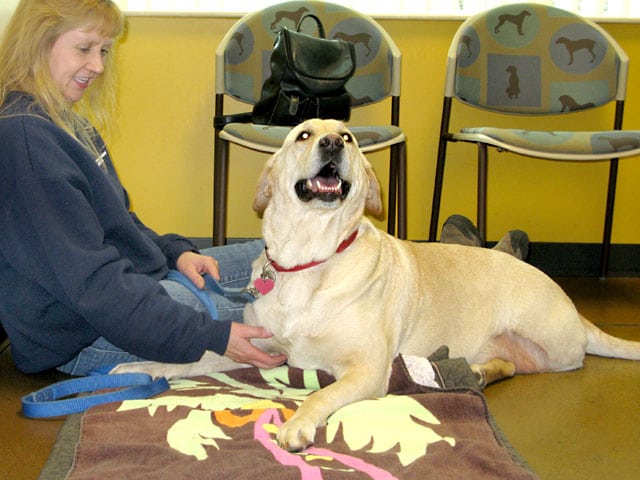Caring for a Three Legged Dog or Cat
Tripawds is your home to learn how to care for a three legged dog or cat, with answers about dog leg amputation, and cat amputation recovery from many years of member experiences.
Join The Tripawds Community
Learn how to help three legged dogs and cats in the forums below. Browse and search as a guest or register for free and get full member benefits:
Instant post approval.
Private messages to members.
Subscribe to favorite topics.
Live Chat and much more!
For most of us, the thought of putting our dog through cancer therapy is a scary proposition. If we don't have previous experience with human or animal oncology, words like “radiation” and “chemotherapy” might conjure up images of day-glow dogs and a traumatic day-long visit at the vet's office.
 In November 2006, when Jerry was first diagnosed and the surgeon mentioned chemotherapy, this is exactly what we pictured. Later, we were reassured to learn that dogs usually suffer fewer side effects than humans and quickly bounce back. Still, we didn't pursue IV chemotherapy for Jerry (he would later undergo the Metronomic Protocol, an at-home oral form of chemo).
In November 2006, when Jerry was first diagnosed and the surgeon mentioned chemotherapy, this is exactly what we pictured. Later, we were reassured to learn that dogs usually suffer fewer side effects than humans and quickly bounce back. Still, we didn't pursue IV chemotherapy for Jerry (he would later undergo the Metronomic Protocol, an at-home oral form of chemo).
As a result, we have never had firsthand experience with a veterinary chemotherapy session. But recently, we were lucky enough to meet the good people at the Veterinary Cancer Group in Southern California and a recent Tripawd named Daisee, who was about to have her first chemotherapy treatment. Daisee's mom Michelle Fountain graciously allowed us to film their appointment, and the VCG staff allowed us to witness all of the steps involved in measuring and administering the carboplatin dose Daisee would receive.
[youtube][/youtube]
According to Daisee's Mom, as of April 2010, Daisee has handled her chemotherapy treatments well and other than a slight 24-hour fever, has not experienced any side effects. Although she can't run as fast as her brothers, she is adapting well to life on three legs, and her family remains hopeful that she will be around a long time.
Just as we were relieved to discover that there was nothing to fear at Jerry's first oncology appointment, nearly three years later we were comforted to see that a chemotherapy session is comfortable, painless and quick. The compassionate and highly skilled staff at VCG gave Daisee all sorts of love and treats, and the session was over before we knew it.
Many thanks to Daisee, her Mom Michelle and the Veterinary Cancer Group of Southern California for allowing us to bring this important information to you.
Stay tuned for more video interviews with Veterinary Cancer Group's founder, Dr. Mona Rosenberg, DVM DACVIM (Oncology).
Since 1992, the Veterinary Cancer Group of Southern California has been committed to taking the fear out of cancer and providing in-depth information and access to the latest treatments. They are the largest, most comprehensive and sophisticated veterinary oncology practice in the world, staffed by leading board-certified medical and radiation oncologists, oncology residents, technicians, assistants and client care specialists.
Learn more about the Veterinary Cancer Group of Southern California by visiting their website at vetcancergroup.com
Tripawds Founders Jim and Rene
tripawds.com | tripawds.org | bemoredog.net | triday.pet
I have to say that I don't know how a dog that had to be sedated for a nail trim did chemo. Not that the chemo looked bad but Emily was high strung. I would suggest if people don't know if their dog can handle it (but want to do chemo) give it a try for one session and see. Emily was treated like a queen, as she felt she should be, and would come out with her stubby tail wagging and doing the butt wiggle. It really is not as hard on dogs as it is for people.
Debra & Angel Emily
Debra & Emily, a five year old doberman mix, who was diagnosed with an osteosaecoma. She had a right rear leg amputation on May 19, 2009. On November 10, 2009 she earned her wings and regained her fourth leg.
1 Guest(s)

 Register
Register Log In
Log In Members
Members

 Read the original blog post
Read the original blog post Add Reply
Add Reply Add Topic
Add Topic Offline
Offline








